#NASA Hubble’s Wide Field Camera 3
Text

SPACEMAS DAY 25 ✨🪐🌎☄️☀️🌕
MERRY CHRISTMAS!!!! These last 25 days have been so fun! Thank you for coming along with me!!
Majestic on a cosmic scale, M100 is known as a grand design spiral galaxy. It’s a large galaxy of over 100 billion stars with well-defined spiral arms that is similar to the Milky Way Galaxy. Also one of the brightest members of the Virgo Cluster of galaxies, M100 (aka NGC 4321) is 56 million light-years away toward the constellation of Berenice's Hair (Coma Berenices). This Hubble Space Telescope image of M100 was taken with the Wide Field Camera 3 and accentuates bright blue star clusters and intricate winding dust lanes which are hallmarks of this class of galaxies. Studies of variable stars in M100 have played an important role in determining the size and age of the Universe.
Image Credit & Copyright: NASA, ESA, Hubble
#astronomy#space#science#universe#spacemas#day 25#christmas#merry christmas#galaxy#Virgo cluster#Milky Way#spiral#spiral galaxy#follow#like#reblog#the first star#the first starr#thefirststar#thefirststarr#nasa#apod#tumblr#blog#tumblr blog#space blog
92 notes
·
View notes
Text
WHAT IS THE FARTHEST THING WE CAN SEE IN SPACE??
Blog#348
Saturday, November 11th, 2023
Welcome back,
Current observations suggest that the Universe is about 13.7 billion years old. We know that light takes time to travel, so that if we observe an object that is 13 billion light years away, then that light has been traveling towards us for 13 billion years. Essentially, we are seeing that object as it appeared 13 billion years ago.
With every year that passes, our newest technology enables us to see further and further back.

The image used for this stop on our journey is the Hubble Ultra Deep Field (UDF). The UDF is one of the deepest views of the visible universe to date; certainly it was the deepest when it was originally created in in 2003-2004. There are approximately 10,000 galaxies in this view, which is a sort of "core sample" of a very narrow patch of sky near the constellation Fornax. The smallest, reddest galaxies in the image, of which there are about 100, are among the most distant known objects!

The UDF looks back approximately 13 billion years (approximately between 400 and 800 million years after the Big Bang). Galaxies that existed in that time period would be very young and very different in structure and appearance than the grand spirals we see nearby today.
In December of 2012, astronomers announced a Hubble Space Telescope discovery of seven primitive galaxies located over 13 billion light years away from us.

The results are from survey of the same patch of sky known as the Ultra Deep Field (UDF). This survey, called UDF12, used Hubble's Wide Field Camera 3 to peer deeper into space in near-infrared light than any previous Hubble observation.
Why infrared? Because the Universe is expanding; therefore the farther back we look, the faster objects are moving away from us, which shifts their light towards the red. Redshift means that light that is emitted as ultraviolet or visible light is shifted more and more to redder wavelengths.

The extreme distance of these newly discovered galaxies means their light has been traveling to us for more than 13 billion years, from a time when the Universe was less than 4% of its current age.
Their discovery, which you can read more about in the NASA feature is exciting because it might give us an idea of how abundant galaxies were close to the era when astronomers think galaxies first started forming. (Phil Plait has a good column about this discovery too.)
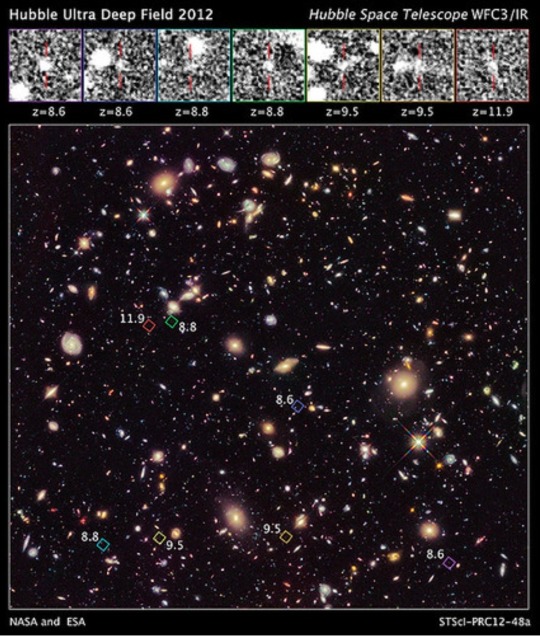
As of this writing it seems that one of the galaxies in this recent Hubble discovery may be a distance record breaker - it was observed 380 million years after the Big Bang, with a redshift of 11.9. This means the light from this galaxy (pictured below) left 13.3+ billion light years ago.

Just under a month ago, the current candidate was this object: a young galaxy called MACS0647-JD. It's only a tiny fraction of the size of our Milky Way - and was observed at 420 million years after the Big Bang, when the universe was 3 percent of its present age of 13.7 billion years. To spot this galaxy, astronomers used the powerful gravity from the massive galaxy cluster MACS J0647+7015 to magnify the light from the distant galaxy; this effect is called gravitational lensing

Originally published on imagine.gsfc.nasa.gov
COMING UP!!
(Wednesday, November 15th, 2023)
"WHERE DID WATER COME FROM ON EARTH??"
#astronomy#outer space#alternate universe#astrophysics#universe#spacecraft#white universe#space#parallel universe#astrophotography
89 notes
·
View notes
Text
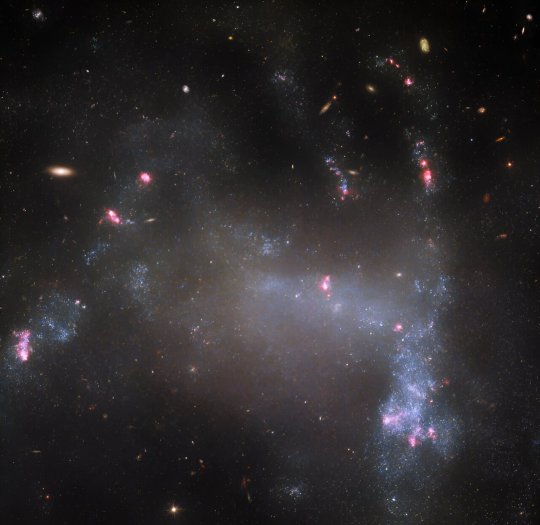
Hubble spots the Spider Galaxy
This image from the NASA/ESA Hubble Space Telescope shows the gauzy-looking celestial body UGC 5829, an irregular galaxy that lies about 30 million light-years away. Despite the lack of observations of this relatively faint galaxy, UGC 5829 has a distinct and descriptive name: the Spider Galaxy. Perhaps its distorted galactic arms with their glowing, star-forming tips hint at the clawed legs of an arachnid.
The data in this image come from two Hubble observing programs. The first used Hubble's Advanced Camera for Surveys to look at relatively nearby galaxies in an effort to build color versus brightness diagrams of the stars in these galaxies. Each observation only took one Hubble orbit (about 95 minutes) but provided a valuable archival record of the types of stars in different galaxies and therefore different environments.
The second program used Hubble's Wide Field Camera 3 to look at star clusters in dwarf galaxies. Their observations leveraged Hubble's ultraviolet capabilities along with its ability to see fine details to better understand the environment where stars form in dwarf galaxies. The star-forming regions of UGC 5829 are readily visible in this image as bright-pink nebulae or clouds.
49 notes
·
View notes
Photo

2023 April 8
M100: A Grand Design Spiral Galaxy
Image Credit: NASA, ESA, Hubble; Processing: Judy Schmidt
Explanation: Majestic on a truly cosmic scale, M100 is appropriately known as a grand design spiral galaxy. It is a large galaxy of over 100 billion stars with well-defined spiral arms that is similar to our own Milky Way Galaxy. One of the brightest members of the Virgo Cluster of galaxies, M100 (alias NGC 4321) is 56 million light-years distant toward the constellation of Berenice's Hair (Coma Berenices). This Hubble Space Telescope image of M100 was taken with the Wide Field Camera 3 and accentuates bright blue star clusters and intricate winding dust lanes which are hallmarks of this class of galaxies. Studies of variable stars in M100 have played an important role in determining the size and age of the Universe.
∞ Source: apod.nasa.gov/apod/ap230408.html
173 notes
·
View notes
Video
No zoom by European Space Agency
Via Flickr:
This image shows a globular cluster known as NGC 1651. Like the object in another recent Picture of the Week, it is located about 162 000 light-years away in the largest and brightest of the Milky Way’s satellite galaxies, the Large Magellanic Cloud (LMC). A notable feature of this image is that the globular cluster almost fills the entire image, even though globular clusters are only about 10 to 300 light-years in diameter (NGC 1651 has a diameter of roughly 120 light-years). In contrast, there are numerous Hubble Pictures of the Week that feature entire galaxies — which can be tens or hundreds of millions of light-years in diameter — that also more or less fill the whole image. A common misconception is that Hubble and other large telescopes manage to observe wildly differently sized celestial objects by zooming in on them, as one would with a specialised camera here on Earth. However, whilst small telescopes might have the option to zoom in and out to a certain extent, large telescopes do not. Each telescope’s instrument has a fixed ‘field of view’ (the size of the region of sky that it can observe in a single observation). For example, the ultraviolet/visible light channel of Hubble’s Wide Field Camera 3 (WFC3), the channel and instrument that were used to collect the data used in this image, has a field of view roughly one twelfth the diameter of the Moon as seen from Earth. Whenever WFC3 makes an observation, that is the size of the region of sky that it can observe. The reason that Hubble can observe objects of such wildly different sizes is two-fold. Firstly, the distance to an object will determine how big it appears to be from Earth, so entire galaxies that are relatively far away might take up the same amount of space in the sky as a globular cluster like NGC 1651 that is relatively close by. In fact, there's a distant spiral galaxy lurking in this image, directly left of the cluster — though undoubtedly much larger than this star cluster, it appears small enough here to blend in with foreground stars! Secondly, multiple images spanning different parts of the sky can be mosaiced together to create single images of objects that are too big for Hubble’s field of view. This is a very complex task and is not typically done for Pictures of the Week, but it has been done for some of Hubble’s most iconic images. [Image Description: A spherical collection of stars, which fills the whole view. The stars merge into a bright, bluish core in the centre, and form a sparse band around that out to the edges of the image. A few stars lie in front of the cluster, with visible diffraction spikes. The background is dark black.] Credits: ESA/Hubble & NASA, L. Girardi, F. Niederhofer; CC BY 4.0
#NGC 1651#ESA#European Space Agency#Space#Universe#Cosmos#Space Science#Science#Space Technology#Tech#Technology#HST#Hubble Space Telescope#Galaxy#Supernova#NASA#Creative Commons#Stars#Star#Globular Cluster#flickr
20 notes
·
View notes
Text
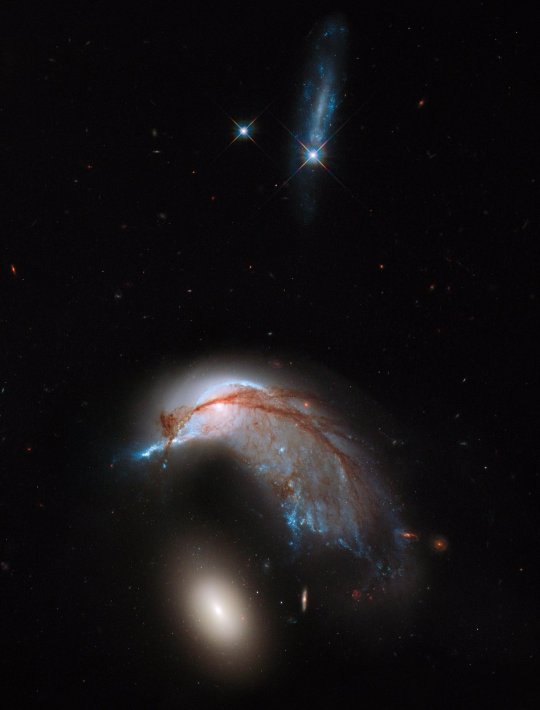
This image shows the two galaxies interacting. NGC 2936, once a standard spiral galaxy, and NGC 2937, a smaller elliptical, bear a striking resemblance to a penguin guarding its egg. This image is a combination of visible and infrared light, created from data gathered by the NASA/ESA Hubble Space Telescope Wide Field Planetary Camera 3 (WFC3).Credit:
NASA, ESA and the Hubble Heritage Team (STScI/AURA)
38 notes
·
View notes
Link
2 min read Hubble Views a Massive Star Forming This image from the NASA/ESA Hubble Space Telescope is a relatively close star-forming region known as IRAS 16562-3959. ESA/Hubble & NASA, R. Fedriani, J. Tan This image from the NASA/ESA Hubble Space Telescope is teeming with color and activity. It features a relatively close star-forming region known as IRAS 16562-3959, which lies within the Milky Way about 5,900 light-years from Earth in the constellation Scorpius. Observations from Hubble’s Wide Field Camera 3 make up this image. Its detailed nuance of color is the result of four separate filters. These thin slivers of highly specialized material can slide in front of the instrument’s light sensors, allowing very specific wavelengths of light to pass through with each observation. This is useful because certain wavelengths of light can tell us about the region’s composition, temperature, and density. At the center of the image, IRAS 16562-3959 likely hosts a massive star – about 30 times the mass of our Sun – that is still in the process of forming. The shadowy clouds appear dark because there is so much light-obscuring dust blocking the near-infrared wavelengths of light Hubble observed. However, near-infrared light does leak out mainly on two sides – upper left and lower right – where a powerful jet from the massive protostar cleared away the dust. Multi-wavelength images like this incredible Hubble scene help us gain a better understanding of how the most massive, brightest stars in our galaxy form. Text credit: European Space Agency (ESA) Download this image Media Contact: Claire AndreoliNASA’s Goddard Space Flight Center, Greenbelt, [email protected] Share Details Last Updated Feb 16, 2024 Editor Andrea Gianopoulos Location Goddard Space Flight Center Related Terms Astrophysics Astrophysics Division Goddard Space Flight Center Hubble Space Telescope Missions Nebulae Protostars Star-forming Nebulae Stars The Universe Keep Exploring Discover More Topics From NASA Hubble Space Telescope Since its 1990 launch, the Hubble Space Telescope has changed our fundamental understanding of the universe. Galaxies Stories Stars Stories NASA Astrophysics
4 notes
·
View notes
Text

𝑻𝒉𝒆 𝑬𝒈𝒈 𝑵𝒆𝒃𝒖𝒍𝒂
NASA image release April 27, 2012 The NASA/ESA Hubble Space Telescope has been at the cutting edge of research into what happens to stars like our sun at the ends of their lives. One stage that stars pass through as they run out of nuclear fuel is called the preplanetary or protoplanetary nebula stage. This Hubble image of the Egg Nebula shows one of the best views to date of this brief but dramatic phase in a star’s life. The preplanetary nebula phase is a short period in the cycle of stellar evolution, and has nothing to do with planets. Over a few thousand years, the hot remains of the aging star in the center of the nebula heat it up, excite the gas, and make it glow as a subsequent planetary nebula. The short lifespan of preplanetary nebulae means there are relatively few of them in existence at any one time. Moreover, they are very dim, requiring powerful telescopes to be seen. This combination of rarity and faintness means they were only discovered comparatively recently. The Egg Nebula, the first to be discovered, was first spotted less than 40 years ago, and many aspects of this class of object remain shrouded in mystery. At the center of this image, and hidden in a thick cloud of dust, is the nebula’s central star. While we can’t see the star directly, four searchlight beams of light coming from it shine out through the nebula. It is thought that ring-shaped holes in the thick cocoon of dust, carved by jets coming from the star, let the beams of light emerge through the otherwise opaque cloud. The precise mechanism by which stellar jets produce these holes is not known for certain, but one possible explanation is that a binary star system, rather than a single star, exists at the center of the nebula. The onion-like layered structure of the more diffuse cloud surrounding the central cocoon is caused by periodic bursts of material being ejected from the dying star. The bursts typically occur every few hundred years. The distance to the Egg Nebula is only known very approximately, the best guess placing it at around 3,000 light-years from Earth. This in turn means that astronomers do not have any accurate figures for the size of the nebula (it may be larger and further away, or smaller but nearer). This image is produced from exposures in visible and infrared light from Hubble’s Wide Field Camera 3.
102 notes
·
View notes
Photo
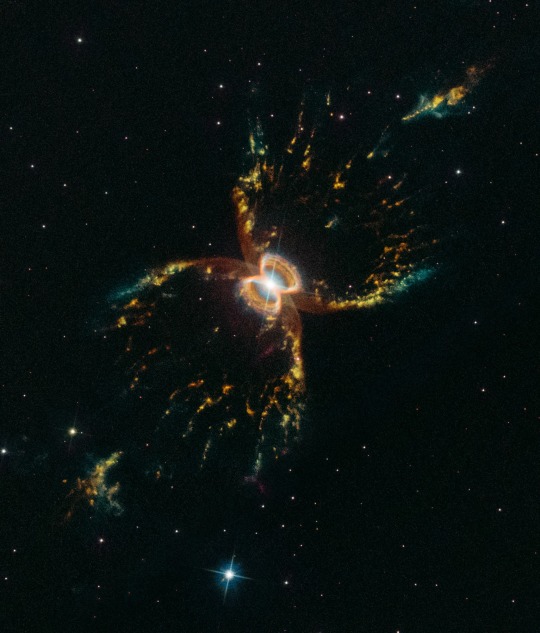
The Crab Nebula
In celebration of the 29th anniversary of the launch of NASA's Hubble Space Telescope, astronomers captured this festive, colorful look at the tentacled Southern Crab Nebula.The nebula, officially known as Hen 2-104, is located several thousand light-years from Earth in the southern hemisphere constellation of Centaurus. It appears to have two nested hourglass-shaped structures that were sculpted by a whirling pair of stars in a binary system. The duo consists of an aging red giant star and a burned-out star, a white dwarf. The red giant is shedding its outer layers. Some of this ejected material is attracted by the gravity of the companion white dwarf.The result is that both stars are embedded in a flat disk of gas stretching between them. This belt of material constricts the outflow of gas so that it only speeds away above and below the disk. The result is an hourglass-shaped nebula.The bubbles of gas and dust appear brightest at the edges, giving the illusion of crab leg structures. These "legs" are likely to be the places where the outflow slams into surrounding interstellar gas and dust, or possibly material which was earlier lost by the red giant star.The outflow may only last a few thousand years, a tiny fraction of the lifetime of the system. This means that the outer structure may be just thousands of years old, but the inner hourglass must be a more recent outflow event. The red giant will ultimately collapse to become a white dwarf. After that, the surviving pair of white dwarfs will illuminate a shell of gas called a planetary nebula.The object was first reported in the late 1960s, but was assumed to be an ordinary star. In 1989, astronomers used the European Southern Observatory's La Silla Observatory in Chile to photograph a roughly crab-shaped extended nebula, formed by symmetrical bubbles.These early observations only showed the outer hourglass emanating from a bright central region. Hubble photographed the Southern Crab in 1999 to reveal complicated nested structures. These latest images were taken in March 2019 with a wide set of color filters on Hubble's newest, sharpest detector, Wide Field Camera 3. This image is a composite of observations taken in various colors of light that correspond to the glowing gases in the nebula. Red is sulfur, green is hydrogen, orange is nitrogen, and blue is oxygen.Hubble launched on April 24, 1990, aboard the space shuttle Discovery. From its perch high above the distorting effects of Earth's atmosphere, Hubble observes the universe in near-ultraviolet, visible, and near-infrared light. Over the past 29 years, the space telescope's breakthrough discoveries have revolutionized nearly all fields of astronomy and astrophysics. Among Hubble's landmark accomplishments include making the deepest views ever taken of the evolving universe, finding planet-forming disks around nearby stars, chemically probing the atmospheres of planets orbiting other stars, identifying the first supermassive black hole in the heart of a neighboring galaxy, and providing evidence of an accelerating universe, propelled perhaps by some unknown source of energy in the fabric of space. Credits: NASA
55 notes
·
View notes
Photo

Hubble Space Telescope
The winding spiral structure of the galaxy IC 5332 is portrayed in amazing detail by this image from the NASA/ESA Hubble Space Telescope. The clarity of Hubble’s Wide Field Camera 3 (WFC3) separates the arms of the galaxy from dark patches of dust in between, which block out the ultraviolet and visible light Hubble is sensitive to. Younger and older stars can be differentiated by their colours, showing how they are distributed throughout the galaxy. Meanwhile, Webb’s MIRI image provides a very different view, instead highlighting the patterns of gas spread throughout the galaxy.
#hubble space telescope#galaxy IC 5332#nasa#nasa picture of the day#space#astronomy#beauty#beautiful#pretty
20 notes
·
View notes
Link
4 notes
·
View notes
Text
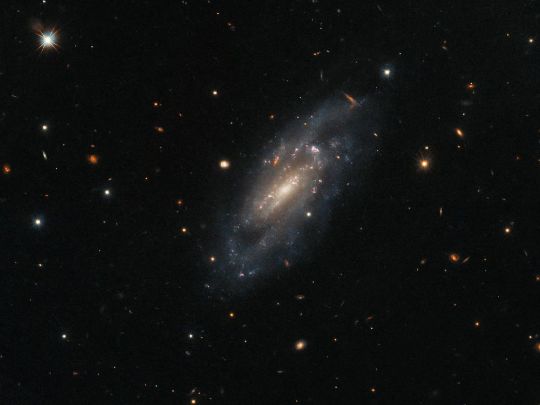
spiral galaxy UGC 11860 seems to float serenely against a field of background galaxies in this image from the NASA/ESA Hubble Space Telescope. UGC 11860 lies around 184 million light-years away in the constellation Pegasus, and its untroubled appearance is deceiving; this galaxy recently played host to an almost unimaginably energetic stellar explosion.
A supernova explosion – the catastrophically violent end of a massive star’s life – was detected in UGC 11860 in 2014. Astronomers used Hubble’s Wide Field Camera 3 to search through the aftermath and analyze the lingering remnants of this vast cosmic explosion.
One team explored UGC 11860 to understand more about the star systems that eventually meet their demise in supernovae. The hugely energetic processes during supernova explosions are predominantly responsible for forging the elements between silicon and nickel on the periodic table. This means that understanding the influence of the masses and compositions of the progenitor star systems is vital to explaining how many of the chemical elements here on Earth originated. - @nasa
Text credit: European Space Agency (ESA)
Image credit: ESA/Hubble & NASA, A. Filippenko, J. D. Lyman
2 notes
·
View notes
Photo
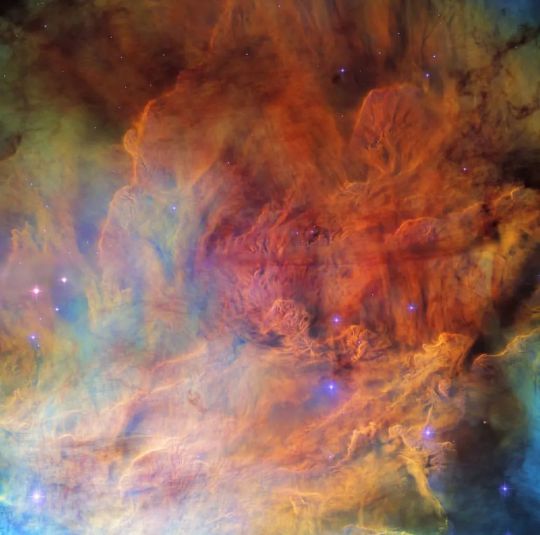
Reposted from @nasa And you have my bow 🏹 A collection of thousands of stars lie around 4,350 light-years from Earth, in the constellation Sagittarius. Set within the Lagoon Nebula – a stellar nursery with scorching temperatures, stellar winds, and powerful radiation – these stars form in a gigantic cloud of interstellar dust and gas. Astronomers use telescopes like @NASAHubble, which captured this image using its Advanced Camera for Surveys and Wide Field Planetary Camera 3, to investigate proplyds. These bright disks surround newborn stars, allowing scientists to study the birth and origins of stars and exoplanetary systems. Image description: In every direction, cloudy waves and bands of red, orange, blue, green, and yellow crash over each other. The clouds appear almost like a liquid, mixing and blending with their surroundings. Small white, blue, and purple dots of stars appear at random throughout the image. Credit: @EuropeanSpaceAgency/Hubble & NASA, O. De Marco; Acknowledgment: M.H. Özsaraç #Hubble #ESA #Space #Nebula #LagoonNebula #Stars #NASA #Universe#eugenelacroix1 @eugenelacroix1 #photography https://www.instagram.com/p/CmWVjHeoS-Y/?igshid=NGJjMDIxMWI=
5 notes
·
View notes
Text
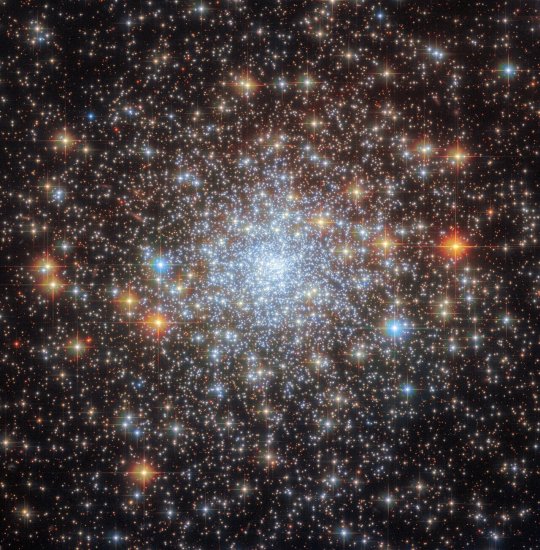
Hubble glimpses globular cluster NGC 6652
The glittering, glitzy contents of the globular cluster NGC 6652 sparkle in this star-studded image from the NASA/ESA Hubble Space Telescope. The core of the cluster is suffused with the pale blue light of countless stars, and a handful of particularly bright foreground stars are adorned with crisscrossing diffraction spikes. NGC 6652 lies in our own Milky Way galaxy in the constellation Sagittarius, just under 30,000 light-years from Earth and only 6,500 light-years from the galactic center.
Globular clusters are stable, tightly gravitationally bound clusters containing anywhere from tens of thousands to millions of stars. The intense gravitational attraction between closely packed stars in globular clusters is what gives these star-studded objects their regular, spherical shape.
This image combines data from two of Hubble's most powerful cameras: the Advanced Camera for Surveys and Wide Field Camera 3. It also uses data from two different observing programs conducted by two different teams of astronomers.
The first team set out to survey globular clusters in the Milky Way galaxy in the hope of shedding light on topics ranging from the ages of these objects to the gravitational potential of the galaxy as a whole. The second team of astronomers used a trio of exquisitely sensitive filters in Hubble's Wide Field Camera 3 to disentangle the proportions of carbon, nitrogen, and oxygen in globular clusters such as NGC 6652.
110 notes
·
View notes
Text
Hubble Views a Billowing Cosmic Cloud
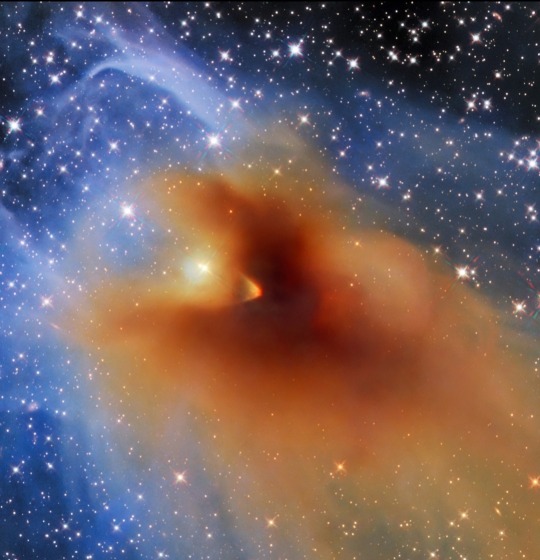
A small, dense cloud of gas and dust called CB 130-3 blots out the center of this image from the NASA/ESA Hubble Space Telescope. CB 130-3 is an object known as a dense core, a compact agglomeration of gas and dust. This particular dense core is in the constellation Serpens and seems to billow across a field of background stars.
Dense cores like CB 130-3 are the birthplaces of stars and are of particular interest to astronomers. During the collapse of these cores enough mass can accumulate in one place to reach the temperatures and densities required to ignite hydrogen fusion, marking the birth of a new star. While it may not be obvious from this image, a compact object teetering on the brink of becoming a star is embedded deep within CB 130-3.
Astronomers used Hubble's Wide Field Camera 3 to better understand the environment surrounding this fledgling star. As this image shows, the density of CB 130-3 isn't constant; the outer edges of the cloud consist of only tenuous wisps, whereas at its core CB 130-3 blots out background light entirely. The gas and dust making up CB 130-3 affect not only the brightness but also the apparent color of background stars, with stars toward the cloud's center appearing redder than their counterparts at the outskirts of this image. Astronomers used Hubble to measure this reddening effect and chart out the density of CB 130-3, providing insights into the inner structure of this stellar nursery.
Text credit: European Space Agency (ESA)
Image credit: ESA/Hubble, NASA & STScI, C. Britt, T. Huard, A. Pagan
5 notes
·
View notes
Text

This striking image features a relatively rare celestial phenomenon known as a Herbig-Haro object. This particular object, named HH111, was imaged by the NASA/ESA Hubble Space Telescope’s Wide Field Camera 3 (WFC3). These spectacular objects develop under very specific circumstances. Newly formed stars are often very active, and in some cases they expel very narrow jets of rapidly moving ionized gas – gas that is so hot that its molecules and atoms have lost their electrons, making the gas highly charged. The streams of ionized gas then collide with the clouds of gas and dust surrounding newly formed stars at speeds of hundreds of miles per second. It is these energetic collisions that create Herbig-Haro objects such as HH111.
WFC3 takes images at optical, ultraviolet, and infrared wavelengths, which means that it observes objects at a wavelength range similar to the range that human eyes are sensitive to (optical, or visible) and a range of wavelengths that are slightly too short (ultraviolet) or too long (infrared) to be detected by human eyes. Herbig-Haro objects actually release a lot of light at optical wavelengths, but they are difficult to observe because their surrounding dust and gas absorb much of the visible light. Therefore, the WFC3’s ability to observe at infrared wavelengths – where observations are not as affected by gas and dust – is crucial to observing Herbo-Haro objects successfully.
Text credit: ESA (European Space Agency)
Image credit: ESA/Hubble & NASA, B. Nisini
#news#science#outer space#astronomy#universo#space science#space exploration#space photography#space#spacelovers#space phantom#astrophysics#astronomy photography#astrophotography#astronomy news#astro community#galaxy
2 notes
·
View notes
